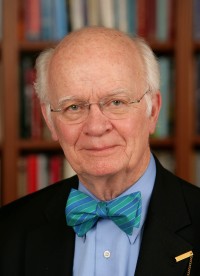Spare places
Near the end of the WPA in 1939, I painted a large round sign for a building in Battle Creek, Nebraska (pop. 702), identifying the “Recreation Hall” and “Theatre.” A photograph of that hall and sign hangs inside our home entrance hall, framed with a little note typed on an old manual typewriter: “This ground-zero view of Battlecreek, Nebraska, in 1947, is for the native son and honored exile Martin Marty, with the fraternal greeting of W. Morris, well known Platte River cattle rustler. This 16th day of December 1993, in the twilight glow of a bloody century. Wright Morris.”
Once or twice later Morris sent postcards with his standard reference to the bloody century. I never met Morris, nor did my son Micah, who framed the print and note. Yet Morris influenced the two of us and his readers immeasurably.
Morris died this spring in California, at age 88, and we mourned him while enjoying quotations in Ralph Blumenthal’s obituary in the New York Times (April 29). Morris won all major awards except the Pulitzer, but Blumenthal said he was “often called one of the nation’s most unrecognized recognized writers.” Unfazed, Morris once said, “I find it harder to account for readers I have than for those I don’t,” and “Everything is not for everybody.”
Morris’s spare, sparse prose combined with clear, stark black-and-white photographs of the Great Plains (and elsewhere) inspired Micah’s and my coauthored books of photos and reflections.
“There never was a people who tried so hard--and left so little behind as we do,” Blumenthal quotes Morris saying of plains dwellers. “There never was a people who traveled so light--and carried so much.” But Morris’s photographs were more about “place” than about people; I can recall only two that showed a person.
Having left Elkhorn and Missouri River country at age 21 and never having returned to live, I’ve maintained my roots on the plains vicariously through the novels of Mari Sandoz, Ole Rolvaag, Willa Cather and, of course, Morris.
In 1948, when at age 20 I first saw Morris’s photo of my “theatre” sign in his pictorial novel The Home Place, I talked to some Battle Creekers, whose environs he had photographed. Postmistress Martin said, “Oh, he just took pictures of old barns and broken-down buildings; he avoided nice houses like Jacob Knapp’s.”
On the way to the library or bookstore to check Morris out, ponder please this last page from God’s Country and My People(1968):
In the century since the Grandfather crossed the Missouri the landscape has not perceptibly changed. To the north the smell of rain, to the south the smoke of dust, to the east rivers of earth still define God’s country. On the daily commute we go into orbit, on the hour we take off. Is there more to come out of a higher standard of living than a predictably lower standard of feeling? Are we more moved by what little we know of the past than by what we dream of the future? Our talent is still for dreaming, and our recurrent dream is flight: a few hours away the luminous fueling stop of the moon. House or ark, sea or plain, shimmering mirages or figures of earth, God’s country is still a fiction inhabited by people with a love for the fact.






